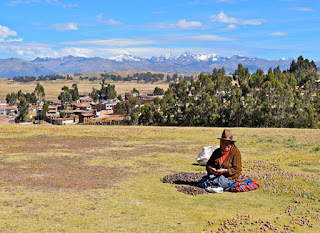What is a politically relevant or salient identity?
In their article "Why Do Ethnic Groups Rebel," Lars-Erik Cederman, Andreas Wimmer, and Brian Min use a modern dataset to explain factors related to the onset of civil conflict among ethnicities. The dataset based on their analysis is the Ethnic Power Relations data set, which documents "all politically relevant ethnic groups and their access to power" (87). Through the study of internal conflicts post-World War II, they argue that the struggle of ethnic groups to attain state recognition and power is a driving force in civil strife.
The article isolates exclusion and competition as driving factors influencing why ethnic groups rebel. This is a substantial finding as it applies to a larger pattern of observations related to rebellion. For example, the success of the Shining Path in Peru can be charted against a history of political exclusion in the country. Peru has a long history of ethnic divisions across its topography, dating back to colonial times. The power relations between "Spanish conquistadores and Indian laborers" reflect the roots of these ethnic fractions, which persisted under the successive governments. Beginning with inflated prices and fines imposed by the Spanish Crown on the "Indian peasants situated in the Andean highlands", this dynamic expanded as colonial Peru developed into an apartheid society (Arena and Arrigo 2006, 153). Over time and political representation, geographic partitions emerged, extending from the exploitation of Indian laborers in these regions. These areas began to reflect economic and ethnic inequalities that widely persist today.
The isolation of politically and economically vulnerable communities enveloped in rural mountainous terrain represents the driving forces towards the countries long-lasting civil war. This political exclusion along ethnic lines led to many ingrained tensions between populations located in the mountainous areas, and the urban centers and the Shining Path terrorist group were able to profit off these tensions.
While it is impossible to make an accurate statement about what would have been if these political exclusions did not exist, their presence can be seen as a motivating factor to conflict. Identities that lack access to political representation may see violence as their only medium for change. For these reasons, I think political relevance describes the access of identity to participation in civic dialogue, without force. Outside of the revelations made by Lars-Erik Cederman, Andreas Wimmer, and Brian Min in their article about ethnic conflict, I think we should remain cautious of drawing barriers to categorize certain groups as politically important because this inherently prioritizes certain groups over others. Political representation and recognition may provide a more helpful lens (compared to political importance) to understand the standing of certain ethnicities.
It is evident that the type of data set analyzed in the study has a considerable influence on the results. I think it would be interesting to examine how these data sets are seeking to quantify the political relevance of ethnicities. Admittedly, I am more familiar with the GROWup (Geographical Research On War, Unified Platform) dataset than the Ethnic Power Relations dataset. The GROWup platform includes "visualization of settlement patterns of politically active ethnic groups around the world from 1946-2017" and "information about ethnic groups' access to executive government power, their involvement in a civil war, federal administrative units, physical elevation, nightlight data, as well as population and GDP data by area" (GROWup). A comparison between datasets that document the saliency of identities could reveal further information related to the assessment of political relevance.
Finally, it is interesting to consider the relationship between political debate and saliency. Does the political discussion of particular identities increase their saliency, or is saliency a condition for widespread political debate? Perhaps a mix of both.
Arena, M. P., & Arrigo, B. A. (2006). The Peruvian Shining Path. In The Terrorist Identity (pp. 152–174). NYU Press; JSTOR. https://www.jstor.org/stable/j.ctt9qg3rr.10



First, this is a great place to bring up the spatial data from PRIO in the form of GrowUp. Indeed if you trace the trajectory of the EPR dataset, it has transformed into GrowUp in order to recognize the role that territory plays in determining political representation. The challenging thing about moving from the country-level down to the within country level is that while you gain in geographic granularity, it is unclear exactly what different levels of political inclusion or exclusion mean for national politics. Take a look at the United States. The map overlays ethnic identity on the U.S. and then classifies how well represented each group is within that geographic area. Latinos in the Southwest are "Junior Partners." But they certainly are not junior partners in each state government or in most municipal governments. They are junior partners in the sense that in some places and in some cases they are descriptively represented. We gain something by knowing this, but how much do we learn about political dynamics by treating this entire region of the U.S. as the same?
ReplyDeleteI appreciate your point that we should be cautious in categorizing certain groups as politically relevant. I agree that it could place value on certain groups over others. However, I also think that many of the most politically relevant identities exist because other groups have historically been valued over them. Political relevance seems to stem from the need for change. Would we consider "white" to be a politically relevant identity? I'm not sure. Thanks for the thought provoking read. I look forward to reading more of your blogs.
ReplyDeleteI think your observation that political relevance has to do with "participation in civic dialogue, without force" is quite interesting. I think you are right that if a group does not have access to participation in the narrative of a governing body, it is difficult for that group to have their members and interests represented. However, I think that in some sense it is possible for groups that are underrepresented or completely excluded from a government to still be relevant. The potential for violence by a group seems like it could create a sort of political saliency, especially if the group is large enough, and even if they are excluded from civic dialogue. Perhaps it then matters from which perspective we consider a group to be relevant? Nice work bringing in other sources!
ReplyDelete